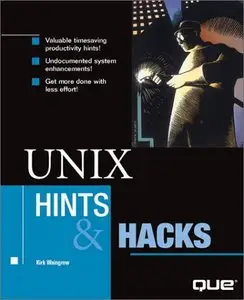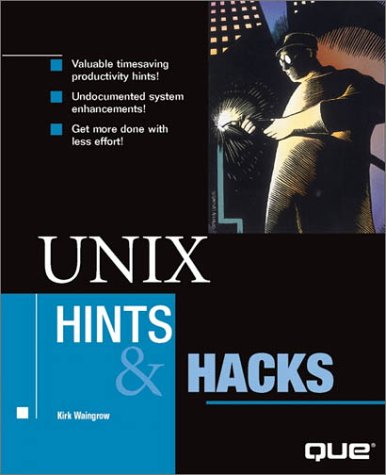"UNIX Hints and Hacks" by Kirk Waingrow
Digirized 2009
Que | 1999 | ISBN: 0789719274 9780789719270 | 465 pages | PDF | 5 MB
Digirized 2009
Que | 1999 | ISBN: 0789719274 9780789719270 | 465 pages | PDF | 5 MB
This book covers the science and art of Unix system administration comprehensively. It is designed to instantly reward you through increased productivity and satisfaction with UNIX. Each and every hint and/or hack provides real value - not just a list of obvious procedures marked as secrets. Learn UNIX administration skills you can apply daily with UNIX workstations and servers. Discover networking tricks to make modifications safely over the network.
Tackle security issues such as dealing with SuperUser accounts, permissions, and vulnerabilities in the UNIX operating system. Develop various ways to monitor the system logs and load averages, to aid in the tuning, fixing, and security. Also learn to add, manipulate, and modify user accounts in new ways, and improve your file management skills for modifying, viewing, and executin. With UNIX Hints & Hacks you'll look up from the reading and say, "I can't wait to try that!""
Table of Contents
Introduction
UNIX Knowledge Needed
Tested UNIX Flavors
Shells and Scripting Languages
Before Beginning
Hints & Hacks Topics
Examples: Commands, Functions, Routines, and Procedures
Symbols, Command Syntax, and Notations
Structure
About the Author
Dedication
Acknowledgments
Chapter 1: Topics in Administration
1.1 Collecting System Information
1.2 Backup Key Files!
1.3 Execution on the Last Day of a Month
1.4 Dealing with Unwanted Daemons
1.5 Keep Those Daemons Running
1.6 fuser Instead of ps
1.7 Swap on-the-Fly
1.8 Keep It Up with nohup
1.9 Redirecting Output to Null
1.10 Keeping Remote Users Out
1.11 Rewinding Tapes Fast
1.12 Generating a Range of Numbers
1.13 Remove the –– Dashes ––
1.14 echo Does ls
1.15 Building Large Dummy Filesence
1.16 Burning-in Disk Drives
1.17 Bringing a System Down
Chapter 2: Networking
2.1 OSI Networking Model
2.2 Finding the Failure
2.3 Hiding Files with NFS
2.4 Remote Network Configurations
2.5 Shutdown, Halt, or Reboot over the Network
2.6 Talking NFS3 to NFS2
2.7 Unmounting and Busy Devices
2.8 Static Routing or routed
2.9 Get the Ethernet Address with arp
Chapter 3: Security
3.1 Delegating root to Multiple Admins
3.2 The Full Path to Superuser
3.3 Monitoring root in the Password File
3.4 Vulnerabilities in UNIX
3.5 Permissions Levels
3.6 Protect root at All Costs
3.7 File Collecting
3.8 File Encryption
3.9 Clear and Lock
3.10 Power Tool
Chapter 4: System Monitoring
4.1 Monitoring at Boot Time
4.2 Starting with a Fresh Install
4.3 Monitor with tail
4.4 Cut the Log in Half
4.5 Mail a Process
4.6 Watching the Disk Space
4.7 Find the Disk Hog
4.8 Watching by grepping the Difference
4.9 Monitoring with ping
4.10 Monitoring Core Files
4.11 Monitoring Crash Files
4.12 Remember Daylight Savings Time
4.13 Checking the Time
Chapter 5: Account Management
5.1 User Account Names
5.2 Passwords
5.3 UID
5.4 Group IDs and /etc/group
5.5 GECOS Field
5.6 Home Directories
5.7 Shells and the Password File
5.8 Configuring an Account
5.9 User Account Startup Files
5.10 Using Aliases
5.11 MS-DOS Users
5.12 Changing Shells
5.13 Finding My Displays
5.14 Copy Files to Multiple Home Directories
5.15 Kill an Account
5.16 Nulling the Root Password Without vi
Chapter 6: File Management
6.1 Copy Files with Permissions and Time Stamps
6.2 Copy Files Remotely
6.3 Which tmp Is a Good Temp?
6.4 Dealing with Symbolic Links
6.5 Finding Files with grep
6.6 Multiple grep
6.7 Executing Commands Recursively with find
6.8 Moving and Renaming Groups of Files
6.9 Stripping the Man Pages
6.10 Clean Up DOS Files
6.11 Splitting Files
6.12 Limit the Size of the Core
6.13 uuencode and uudecode
Chapter 7: Displays and Emulations
7.1 Terminal Types
7.2 Setting Terminal Types
7.3 Make Use of stty
7.4 Hotkeys
7.5 Testing ASCII Terminals
7.6 Troubleshooting ASCII Terminals
7.7 Sharing STDIN/STDOUT on Two Terminals
7.8 Refreshing X
7.9 Killing Resources with xkill
7.10 Setting xterm Titlebars
7.11 Control the Mouse with the Keyboard
7.12 Display from a Remote X Server
7.13 ASCII Table in UNIX
Chapter 8: Editors
8.1 The Anatomy of ed & vi
8.2 The Six Steps to ed
8.3 Six Simple Steps to vi
8.4 Configuring vi Parameters
8.5 Abbreviating vi Commands
8.6 Creating Macros
8.7 Search and Replace
8.8 Other Places to Use vi
8.9 Editing Multiple Files
8.10 Edit, Run, and Edit Again
8.11 Reading STDOUT into vi
8.12 Using vi when tmp Is Full
Chapter 9: Users
9.1 Six Types of Users
9.2 New Users
9.3 Public Relations
9.4 Leave Big Impressions with Little Things
9.5 Handling an Irate User
9.6 Helping Users with Online Tools
9.7 Users Borrowing Equipment
9.8 Outage Notifications
9.9 Users Who Take Care of You
9.10 When Users Leave
Chapter 10: System Administration: The Occupation
10.1 Three Levels of Administration
10.2 Functions of an Administrator
10.3 Finding a Job Working with UNIX
10.4 Preparing an Administrator's Résumé
10.5 Preparing for an Interview
10.6 Types of Interviews
10.7 Being Interviewed
10.8 Finding the Right Person for the Job
10.9 Interviewing Candidates
10.10 Working with Vendors: Sales and Maintenance Representatives
10.11 Working with Vendor Support
10.12 Working with Local Support Engineers
Appendix A: Basic Scripting Concepts
Building a Script
Recursive Scripts
Appendix B: System Installation Checklist
System Installation Check List
Appendix C: System Incident Log
System Incident Log
System Incident Log
Appendix D: Administration Tools and Recommended Organizations
System Administration Tools
Networking Tools
Recommended Organizations
Appendix E: Glossary
Index
with TOC BookMarkLinks



